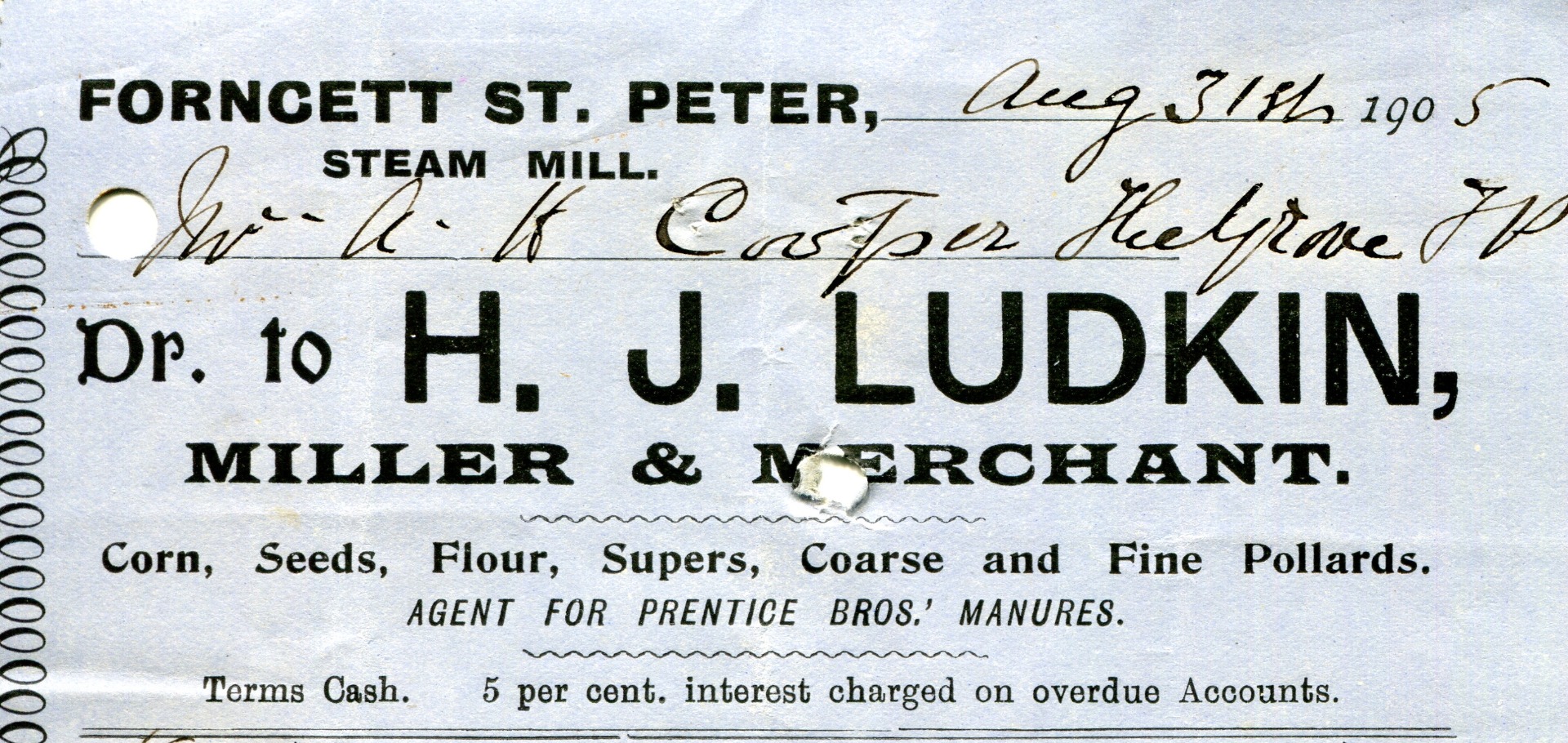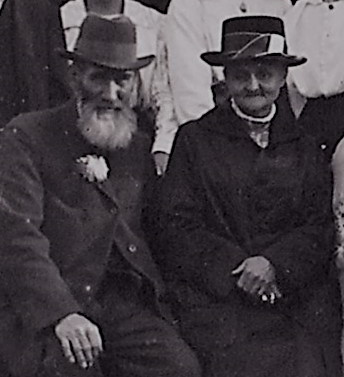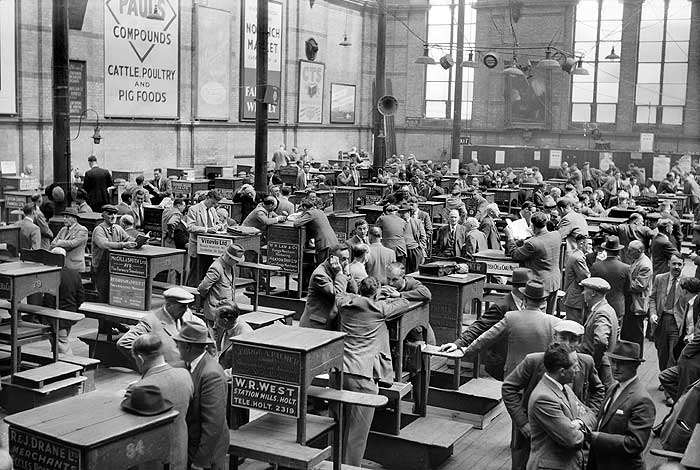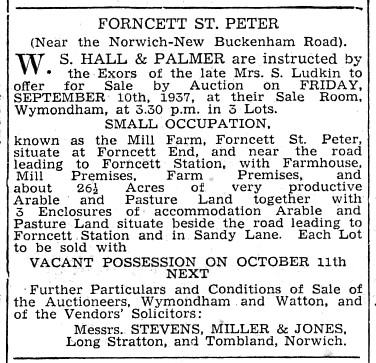
Ludkin's Mill
Henry John Ludkin was born in Forncett St. Mary in 1856. He was the son of a farmer, John Ludkin (1823-1894). Henry married a local girl, Susanna Browne, in 1878 and they set up home close to the Methodist church in Forncett End.

Henry John Ludkin and Susanna Ludkin at the wedding of their daughter, Agnes, in October 1919
In the 1881 census Henry described himself as a "seed grower and
merchant" but by 1883 White's Directory described him as a "miller, merchant and
seed grower". So, it seems that Henry Ludkin had recognised the potential of
the new roller mills as a means of grinding flour and had decided to set up the
first steam mill in Forncett. The mill was obviously a success, and by 1892 Ludkin was
recruiting extra labour.

Norfolk News - 6 August 1892
Ludkin built the mill between his house and the road and it is clearly visible on the 1905 Ordnance Survey map of the village.

1905 Ordnance Survey map - Ludkin's Mill marked in red
Unfortunately, we have no photographs of the mill at this time, but it was recalled in the reminiscences of two young girls living in Forncett in the 1920s:
Susanna Saunders (née Ludkin) was one of Henry John's granddaughters.
" My grandfather owned the farm (Hill Farm in Cheney's Lane) & came down from Forncett End every day in his pony trap, he owned the mill & I remember the engine inside a shed & the thick rubber bands which were always running at work times. My granny was in the shop where they sold flour, chicken feed & the corn from the fields, this was near the Methodist chapel at Forncett End."
Muriel Rowe (née Pymer) lived at Maltings Farm in Forncett End and was related to Henry's daughter, Jessie Ludkin.
"In the afternoon Aunt Jessie would take little Stanley in his pram to see her parents, who owned the mill, and I would go with them. It was great fun watching the corn grinding and the smoke coming out of a very large steel chimney going "chuff-chuff-chuff". Nobody ever complained about soot on their washing. We would play in the orchard and then have tea in the mill house, and then return back to Aunt Jessie's, where another meal was being prepared with lovely smoked sprats fried."
A further memory came from Gerry Smith who lived at the Mill House in the 1970s:
"In front of the present 'Old Mill' stood the grinding mill itself enclosed in a shed with a chimney stack emerging from the roof. A drive belt connected the steam engine with the grinding stones in the main building. There was a deep well for water at the end of the building."

In his role as a corn merchant, Henry John Ludkin had a stall at the Norwich Corn Exchange where he sold his corn.

Norwich Corn Exchange in Exchange Street (photo - George Plunkett)
The Corn Exchange was built in 1861 on the corner between Bedford Street and Exchange Street. It was demolished in 1964 and replaced by an extension to Jarrold's department store. Designed as a place for farmers and dealers to strike their bargains, the Exchange seems also to have been a venue for socialising.

Norwich Corn Exchange in the 1960s - photo Hallam Ashley
In his reminiscences on life at Corner Farm in the 1920s, Ted Thurston recalled visiting the Corn Exchange:
"We sold the corn at Norwich Corn Hall, which was part of the building that is now Jarrolds, in Exchange Street. Halfway down the present Exchange Street there was a large Victorian building which was a corn market. You'd take your samples there and show them to the buyers. The buyers had a stand; they'd look at your samples in a little bag and they'd bid you a price. You argued about the price and he (father) would try to get the best price he could according to the sample."
By 1901 Henry had taken on his son, Albert (1879-1961), as an assistant miller and Albert worked at the mill until the death of his father in 1933. A measure of Henry John Ludkin's success as a miller and corn merchant is given by the fact that he left over £9500 at his death (equivalent to more than £500,000 today).
Henry's wife, Susanna, continued to live at what is now known as The Mill House until she died in 1935. The property, then known as Mill Farm, was finally sold in September 1937.

Eastern Daily Press - 21 August 1937
The sale included the farmhouse, 26 acres of land and the mill premises. However, Albert, who was his mother's executor, was described in the probate as a farmer and not a miller, suggesting that the mill had probably ceased working sometime after Henry Ludkin's death in 1933. Albert and his wife, Lucy, moved to live at Elm Tree Farm in Tabernacle Lane.
In 1939 Mill House was home to Mr. W. G. Thurston, a
salesman for animal feed, and no relative of the family who farmed at Corner
Farm. The mill building itself was converted into a dwelling house, now known
as "The Old Mill", by Fred Humphreys who then lived there.
In 1997, Geoffrey Squire, a distinguished costume historian, came to live at Mill House.
With thanks to Dennis Ludkin and Trish Bright for help in researching this article.
